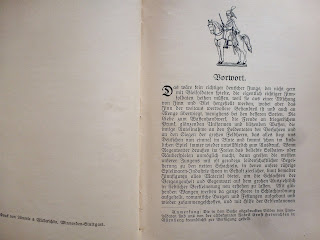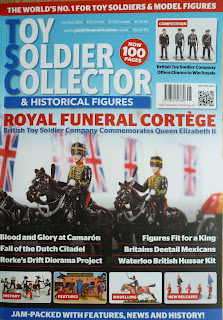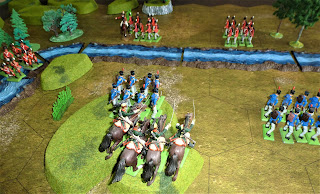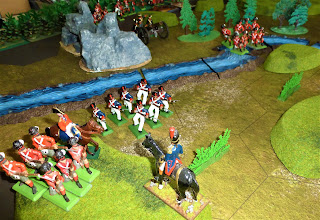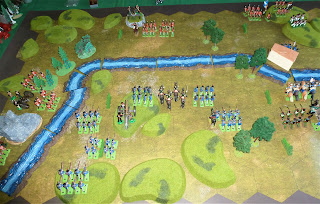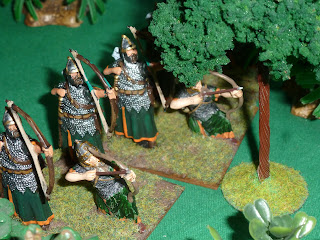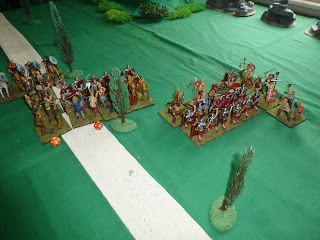It's been a while since we last had a game but this weekend I finally managed to clear enough space for one. Battle Ravens is a board game designed by Dan Mersey with graphics provided by Peter Dennis, both well known names in the gaming world, the former for rules systems and the latter for his excellent ranges of paper soldiers. The game is about combat in a Viking/Saxon shieldwall and comes with opposing 35mm armies of Peter's card mounted paper soldiers. Anthony thought it would be good to play using 54mm toy soldiers so I dusted off the Dark Ages collection and this is how it went:

The two armies square up to form shieldwalls, each has armoured Hirdmen (Hearthguards) in the front line, unarmoured Bondi in the second line and a group of Thrals (skirmishers) behind them. The command units overseeing each shieldwall have no role in the game but I included them to represent the players, and because they look good.
Each shieldwall is split into 6 areas, delineated here by the use of movement trays, at the start of the game players dice to see who goes first and then take it in turns to allocate tokens (Ravens) to each area of their shieldwall, Ravens are used to pay for activity in each area, either attack, defend (saving throws) or to move between areas.
Player A selects one area in their shieldwall and pays with its' Ravens to either attack or move, but not both. To attack, Ravens are payed to buy dice throws, a score of 6 is two hits and 4 or 5 gives one hit. combat takes place against troops in the immediately opposite area, two hits will kill a Hirdman and one hit kills a Bondi. If there are casualties Player B can now pay some of the Ravens from the area being attacked to buy saving dice throws: 6 saves two hits and 4 or 5 saves one hit.
Player B then selects an area of his wall to activate and either attack or move.
To move, one Raven is paid for each figure to be moved to an adjacent area and no more than 9 figures can be placed in any one area.
When the Ravens in all the areas on both sides have been spent it is the end of the turn and a new turn begins with both players alternating, as before, to allocate Ravens to areas in their shieldwall.
The Playmobil pirate ship above is perfect for 54mm toy soldiers, it was a cheap car boot find and plays no role in the game but looks great so I had to include it for a bit of set dressing.
The three bowmen behind the shieldwall are Thralls and they allow failed attacking dice throws to be rerolled, for each reroll one Thrall is removed from the board, at the start of the next turn any Thralls that were removed are returned to the game.
Each player also gets 5 bonus cards which reflect the national characteristics of of the armies and allow additional actions, just one card can be played each turn. The basic game offers expansion kits of these cards to allow for armies of Scots, Welsh and Normans.
The simple game system is very easy to learn and quick to play, despite this we made some inevitable errors in our interpretation of the rules and soon learned that the apparent simplicity masks some subtle nuances which emerge as the game progresses.
As wargames with 54mm toy solders go, Battle Ravens can be played in a very small area, across a dining table would be ideal, and with very few figures required. We used 18 Hirdmen, 18 Bondi and 3 Thralls per side so only 78 figures needed in total.
The sail billows in the wind, sending the longship scudding across the waves towards the estuary where the surf crashes against the treacherous rocks.
I really enjoyed building these Dark Ages armies and was it was great to get them on the table, using 54mm toy soldiers makes a massive difference to the visual impact of the game. There's a great variety in the painting and poses of the figures which include Timpo, DSG, TSSD, Emhar, Cherilea, Del Prado, Co-Ma, Jean Hoefler, Jecsan, Conte, Fontanini, Replicants, Marx, Almies in Plastic, Technolog, NeTechnologist and Cafe Storme.
We both felt it was a great system for portraying the desperation of the shieldwall, the frustration of battering away trying to force a breach while urgently rushing to shore up the holes in your own wall before it collapses, now I know what it feels like being Uhtred in one of Bernard Cornwall's Last Kingdom novels.












